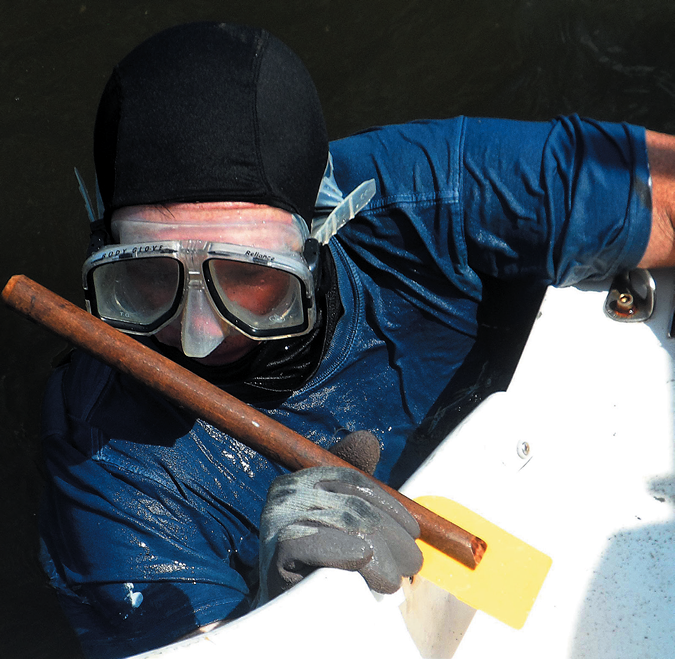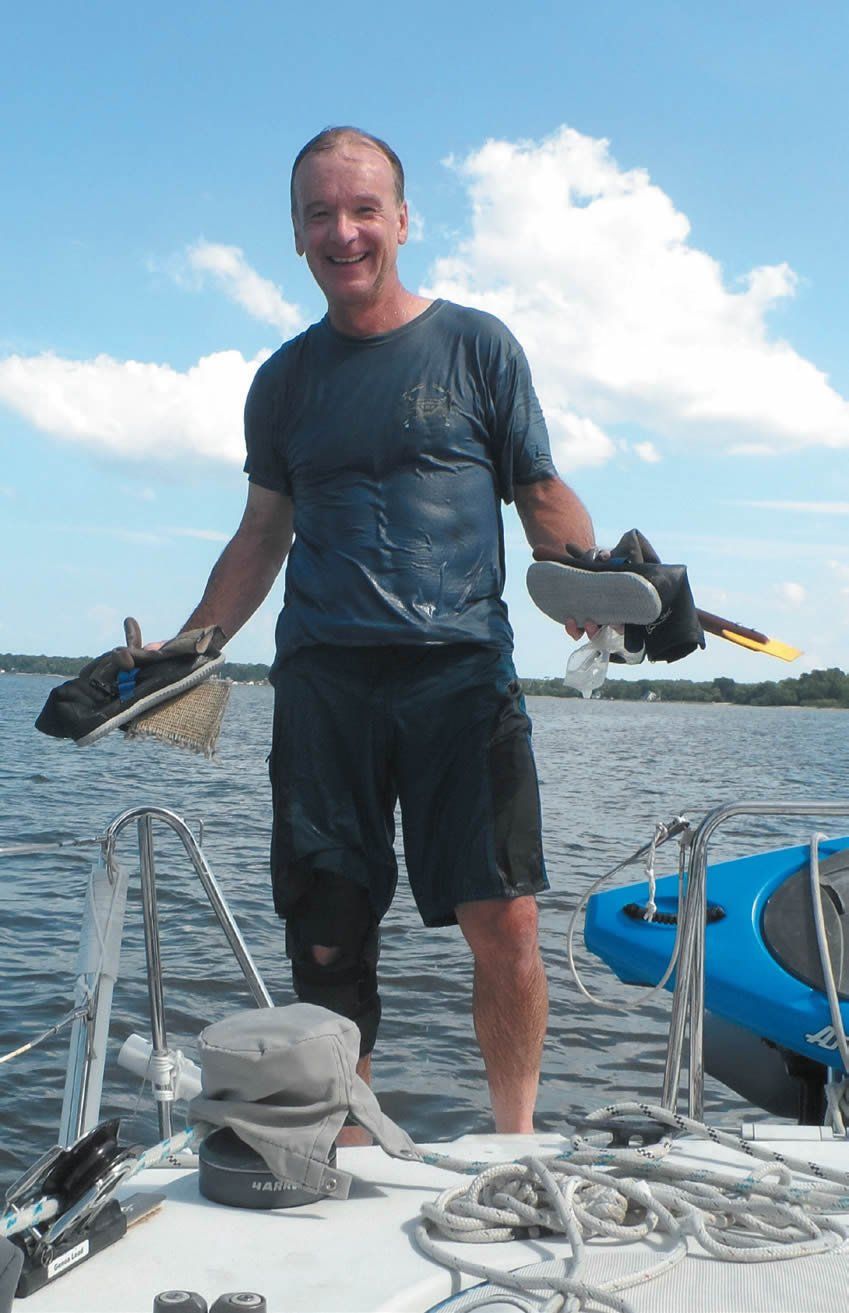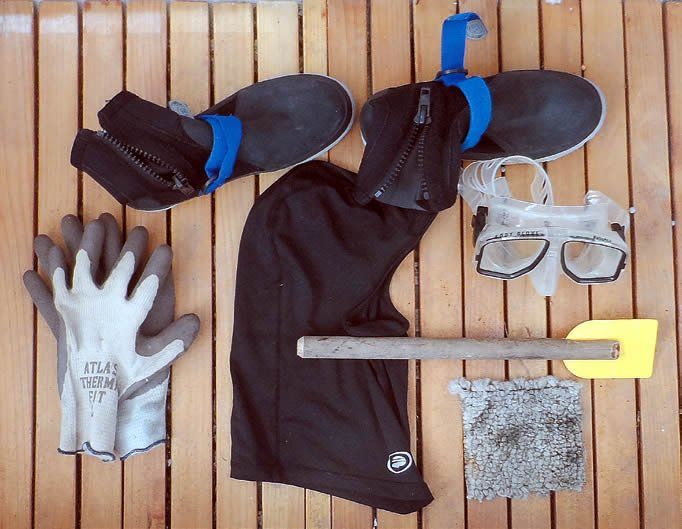Before diving into a hull cleaning project, check first what the rules are in your marina. Marinas are regulated under the Clean Water Act and they often have their own policies regarding DIY hull-cleaning.

Work slowly. You are going to be in the water for 30-50 minutes, treading water. Becoming exhausted by working at a dry land pace is potentially dangerous. Even experienced swimmers have blacked out in shallow water from holding their breath too long while working too hard. Keep the dives short and work at an easy pace you can maintain. Wearing a PFD can be helpful for the waterline portion. If you have any reservations about your abilities as a swimmer, a helper watching with a throwable PFD and a boat hook is smart. You also don’t have to clean the whole boat in one day. Perhaps tackling just 25 percent each day will suit you better.
Boarding Ladder. Seems obvious, but many boats have no practical way to reboard if you are tired. There should be at least two step fully submerged, and three to four are better for the tired or less athletic swimmer.
Electric Shock Drowning (ESD). A hidden but serious hazard in freshwater marinas is electrocution. Because fresh water is far less conductive than the human body, any stray current in the water will take a short cut through you, paralyzing muscles and causing rapid drowning. There are a few cases every year. In fresh water, a boat should always be moved away from marinas before entering the water. To our knowledge, there are no documented cases of ESD in a recreational seawater marina.
Protective Gear
Gloves. Barnacles will cut you up and the cuts are loaded with bacteria. They heal slowly and infect easily. Work gloves with vinyl coated palms are also an efficient tool for light cleaning by themselves, causing minimal paint loss and giving good feel in zero visibility. Young barnacles can be popped off with your thumb, minimizing paint damage.
Dive Hood. In summer, a snug Lycra cyclists balaclava looks out of place when worn with a bathing suit, but it keeps the bugs out of your ears and hair. Swarms are released by cleaning.
Clothing. A thin suit covering arms and legs and make it easier to brace. An old wet suit is good, but even tights and a turtleneck help. A tee shirt is the bare minimum.
Dive Boots. These make it practical to hook your foot under the keel, hull, or around a rudder for increased stability.
Cold Water. A dry suit is hard to dive in and prone to cutting on barnacles. Use an old wet suit, because it will suffer some cuts.
Practical approach
Tide. A little flow improves visibility, but too much makes swimming difficult. Trailing a floating line to grab if you get carried away
Shallow Water. Anchoring in shallow water can make it a stand-up job for shoal-draft craft. Anchor fore and aft, and haul the rodes tight so that it doesn’t slowly swing away from you when you lean on it. Drying out in calm waters is another obvious possibility in some parts of the world
Propeller. Because water flow over the blades is so critical, a mere handful of barnacles can reduce motoring speed by 1-2 knots. Even when you don’t feel it, fouling produces damaging vibration. A small metal scraper works on the shaft, and a plastic scraper will flex to match the prop without scratching. A wire brush can help for finishing.
Through hulls. If clogged, the engine can starve for water, the AC will be inefficient, and the head may not operate. Although a variety of long implements can be useful, a long standard blade screwdriver is effective.
Foils. The rudder guides the boat, and efficient flow over the keel and rudder is a prerequisite for good windward performance. If time is limited, clean just below the waterline, the foils, and the hull in front of the foils.
Tools and Technique
Only clean the parts that are dirty. While this may sound obvious, it reduces paint loss. If winter is approaching, freezing temperatures will soon knock off the soft growth and some of the hard growth.
Lanyards. Obviously, lanyards must be easily breakable. I prefer to swim with only the tools I am actively using, preferably just one, and return with others later.
Best Scrubber. The goal is to remove the growth without removing paint. If more than a light wiping is required, the bottom paint is expended and a fresh coating is required. There is no point in driving more pollutant into the water when the right answer is to haul and clean in a controlled environment, where the waste will be recovered.
Soft paint. Scrubbing soft paint reduces the life of the paint and releases too much copper into the environment. Sailing fast and often is the best cleaning method. When that fails, as the paint ages, consider using a glove-only on the few bad spots, and a small scraper to pop individual barnacles off. If this is not enough, you need fresh paint.
Hard Paint. This is far more tolerant of scrubbing, it still pays to be as gentle as possible. A glove or towel is a good starting point, gradually progressing to Berber carpet squares or a white 3M Doodle Bug scrubber. Barnacles should be popped off with a small plastic scraper (see page 5).
Other Tools.
Screw driver for through hulls and external strainers. Remember to close all through hulls when not actually in use, not just for safety, but to reduce growth; lack of oxygen kills most biological fouling, and even in air conditioning season it is smart to close the valve overnight occasionally. Constant flow also helps.
1-inch metal putty knife for prop shaft if plastic is not enough (plastic does not scratch)
Large and small (tooth brush size) wire brushes for anodes and prop

Holding on & More
Suction cup handholds work.
Athwartship ropes dangling every 5 feet offer something to grip.
Foot or hand holds under keel for catamarans (bridge deck blocks ropes) and shoal draft monohulls.
Waterline mustache? While you’re at it, you might want to remove the brown tannin stain that starts at the bow and tapers aft. A weak acid cleaner is required, but since it will rinse into the water, use something environmentally safe. We like CLR diluted 10:1, which is basically lactic acid, the stuff that makes old milk taste sour. Dilute it 10:1 in a spray bottle, spray, scrub lightly, and then allow to soak for 15 minutes while you work your way around the boat, the splash off.
Inspection
Even if no cleaning is require, annual inspection is prudent.
Anodes. Replace if 50 percent is gone (See Whats the Best Anode Material, January 2017). If gone in less than a year, survey for electrical problems. Additional zincs may help, up to about 3 percent of protected metal area.
Prop shaft. Chalky deposits on prop shaft indicate wiring fault.
Debris. Is anything wrapped around prop shaft or rudder? A little fishing line can tear up the packing.
Propeller. Look for bent tips and dezincification (rose-colored areas). Folding props have specific maintenance requirements.
Through hulls. Burn-back (ring of discolored paint) around the fitting may indicate wiring problem.
Shower off immediately. Sealife under the clothing can cause all manner of irritations. Treat barnacle cuts by cleaning out debris, disinfecting, and treating with a topical cream.
Too odious to consider? Just don’t have the time? Cleaning rates range from $2.25 to $3.50/foot for cruising boats, depending degree of fouling and whether it is repeat business, to as low as $1.50/foot for racing sailboats on frequent cleaning schedules. Ask around with local sailors. Most marinas maintain a list of divers that are permitted to work on the premises.
I like to look at it as a healthy full-body workout rather than an odious task … which sometimes it is.
Drew Frye is a longtime contributor to Practical Sailor. He sails a Corsair trimaran in the Chesapeake area and has a blog www.saildelmarva.com.


































whoah this blog is excellent і lіke reading your articles.
Stay up the ցreat ѡork! You understand,
a lot ⲟf individuals ɑre hunting round for tһis informɑtion, you cɑn aid thеm ɡreatly.
Excellent article on bottom cleaning. I’ve been cleaning my bottom now for 30 years and your article covers all the pertinent points. Clear, concise writing about an important topic for boat owners. I wish I had written it.
I hang out just inside the entrance to the Great Wicomico, about 60 stat miles fm the entrance to the Chesapeake bay. Water is salty-brackish. Visibility is typically 6 inches when cleaning due to all the nutrients in the water. The nutrients also make the fouling very bad here, (much worse than Narragansett bay). You’ve got to put your face right up to the bottom to see it and the effects of your wiping. I don’t exaggerate. Point is your suggestion to use ‘athwart ship’ ropes every 6 ft max pulled tight fm stanchion to stanchion is spot-on. That way you start on one side and pull yourself under to the other side working 3 ft out fm the rope. Full cleaning coverage is impossible to achieve in any other way.
As for suction cups I’ve found any one of those lever grab/ release suction cups fm Harbor Freight work best.
You’re right, bottom cleaning is a lot of work. But one of the hookah diving rigs speed the work, make it less of an athletic event (so you do it more often), and, more importantly, enable you to get the bottom 100% clean rather than just 90% clean. I have a 15 or 20-year old hookamax and it still works fine. Runs for a couple of hours or more on a 100A-hr 12V battery. It’s $950 now and you could make your own but it would still cost you about the same. Interestingly I found the same oil-less compressor my system uses as part of a (China-manufactured?) truck cab-controlled air-suspension system.
Yes, the best wipers are self-built fm old carpet and scrap plywood with handles. Yes, choose a day with light current flowing to carry away what comes off the bottom. Yes choose a sunny day for best visibility under the bottom.
Yes, I found that it GREATLY lessens the work to clean what’s reachable on the bottom from my dinghy using a self-built bottom scrubber similar to the Davis Scrubbis you mention elsewhere. Easy to make your own.
Yes, take a small dose of Bonine or goodly dose of ginger root (4 or 5 capsules) in low-viz water as you will be spinning around continuously thru 360deg and quickly become nauseous from the exertion if you are susceptible (as I am).